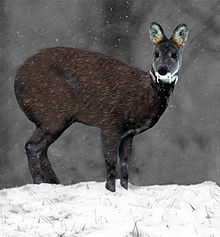| Moschidae Temporal range:
| |
|---|---|

| |
| Skeleton of Micromeryx, a typical moschid from the Miocene epoch | |

| |
| Moschus moschiferus, the extant Siberian musk deer | |
| Scientific classification | |
| Domain: | Eukaryota |
| Kingdom: | Animalia |
| Phylum: | Chordata |
| Class: | Mammalia |
| Order: | Artiodactyla |
| Infraorder: | Pecora |
| Superfamily: | Bovoidea |
| Family: | Moschidae J. E. Gray, 1821 |
| Type genus | |
| Moschus Linnaeus, 1758
| |
| Genera | |
|
See text | |
Moschidae is a family of pecoran even-toed ungulates, containing the musk deer (Moschus) and its extinct relatives. They are characterized by long 'saber teeth' instead of horns, antlers or ossicones, modest size (Moschus only reaches 37 lb (17 kg); other taxa were even smaller) and a lack of facial glands.[1] While various Oligocene and Miocene pecorans were previously assigned to this family, recent studies find that most should be assigned to their own clades, although further research would need to confirm these traits. As a result, Micromeryx, Hispanomeryx, and Moschus are the only undisputed moschid members, making them known from at least 18 Ma.[2][3] The group was abundant across Eurasia and North America during the Miocene, but afterwards declined to only the extant genus Moschus by the early Pleistocene.
- ^ University of Michigan Museum of Zoology - Animal Diversity Web - Moschus (musk deer) Classification
- ^ Mennecart, Bastien; Aiglstorfer, Manuel; Göhlich, Ursula B.; Daxner-Höck, Gudrun (2019). "On the oldest Mongolian moschids (Mammalia, Ruminantia) and the early moschid evolution". Palaeontologia Electronica (22.2.53). doi:10.26879/959.
- ^ Aiglstorfer, Manuela; Wang, Shi-Qi; Cheng, Jie; Xing, Luda; Fu, Jiao; Mennecart, Bastien (2023). "Miocene Moschidae (Mammalia, Ruminantia) from the Linxia Basin (China) connect Europe and Asia and show an early evolutionary diversity of a today monogeneric family". Palaeogeography, Palaeoclimatology, Palaeoecology. 619. doi:10.1016/j.palaeo.2023.111531.